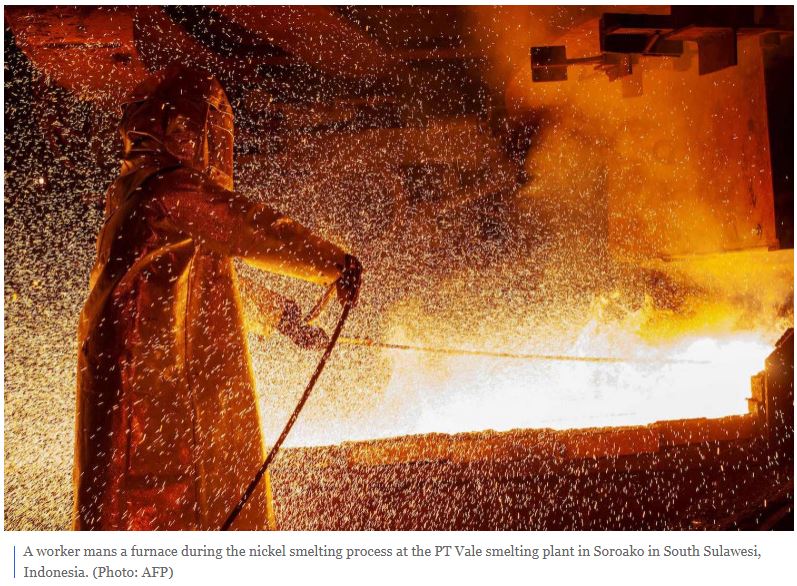Indonesia on value-adding crusade
The value of Indonesia’s nickel exports surged tenfold in five years after it forced buyers to set up refineries in the country. Now Southeast Asia’s biggest economy plans to use that blueprint to vault nto the ranks of higher-income economies by processing everything from copper to fish.
The goal is to double per-capita gross domestic product (GDP) to copy0,000 by 2045, which would bring Indonesia close to the World Bank’s high-income threshold. At the same time, the shift would create new centres of growth outside Java, its richest and most populated island.
“We’re using nickel as the prototype,” said Investment Minister Bahlil Lahadalia. “It’s silly. We have the raw materials, but we sell it to be refined overseas then we import it back. Where did we leave our brain?”
President Joko Widodo points to the economic models of Taiwan and South Korea, two of only handful of nations that managed to escape the so-called middle-income trap by building manufacturing and raising productivity.
For decades, Indonesia has relied on exports of raw commodities — an economic strategy prone to the so-called resources curse, where mineral rich nations suck in investment in mining during boom times, but suffer when commodities prices tumble.
The new roadmap to more onshore processing will begin with oil and gas this year, then fisheries. Down the line, Indonesia will only export refined palm oil, coconut products, timber, seaweed and even salt. The government estimates the drive could pull in $545 billion worth of investment — about half the country’s current nominal GDP.
“We used to sell the Indonesia story by the numbers: 280 million people, thousands of islands, and so on. That’s promoting history, not investment,” Lahadalia said. “Now we tell them: ‘What industry do you want? Here’s what you can make and here’s where you can do it.’”
The investment ministry publishes a menu of projects that investors can choose from, complete with the expected rate of return, breakeven timeline and state incentives available. It includes, for example, a 49.8-billion-rupiah ($3.3 million) cocoa bean factory in Central Sulawesi offering a 22% return, or a copy.13-billion copper refinery in East Java with a 16% expected return.
There are signs the policy could work. The country charted its largest-ever trade surplus last year, with investments rising 44% to a record $80 billion, underpinned by nickel and copper that are mainly found on islands outside Java.
In North Maluku, investments in nickel refining expanded the province’s economy by 29% last year.
“Companies have mined nickel there for decades, but it’s only now that we see this massive growth,” said Lahadalia. “With growth, comes jobs. People don’t have to go to Java anymore to look for good jobs.”
In West Papua, one of the country’s poorest provinces, factories are being built to turn natural gas into methanol, urea and ammonia to be used as fertilisers. And throughout the archipelago, plants are being set up to process and package tuna and shrimp ready for consumers, rather than shipping the catches to facilities in Thailand or Vietnam.
Still, Indonesia’s nickel windfall was partly a result of a sudden surge in global demand from factors including the ramp-up of battery production for electric vehicles and a notorious short-squeeze on the London Metals Exchange that gave Indonesia a strong bargaining position to force miners to build smelters.
There are also questions over how the government will turn the billions of dollars in smelter investments into wider investment in technology and high-skilled jobs that would boost overall productivity.
There are also legal risks. The World Trade Organization recently ruled in favour of the European Union’s protest against the ban on nickel ore exports. Jokowi has vowed to appeal the ruling and refused to change his policy.
And while Indonesia so far has relied on export bans to force companies to build local downstream facilities, the government has said it wants now to take a softer approach, gradually removing incentives for less-refined goods. For nickel, that means no more tax holidays for smelters that put out products with less than 40% nickel content as the government pushes for at least 70-80%.
“But we won’t wait,” Lahadalia said. “If we say the industry needs to be ready before we stop exports, it would take too long and we would get the same old excuses.”
For the copper giant Freeport-McMoRan Inc, whose local unit has been mining one of the world’s largest deposits of copper and gold since the 1970s, exports of concentrates will stop at the end of this year, when a new smelter needs to be up and running, he added.
Lahadalia is confident the downstreaming strategy won’t be derailed by elections in February next year, when Jokowi must step down after the end of his second term. The shift is already locked into the economy as smelters and factories are already being built, he said.
“Besides, anyone who reverses this would be laughed at,” he said. “We’re halfway there. Why would we go back?”
 Source: https://www.bangkokpost.com/business/2514876/indonesia-on-value-adding-crusade
Source: https://www.bangkokpost.com/business/2514876/indonesia-on-value-adding-crusade


 Thailand
Thailand




